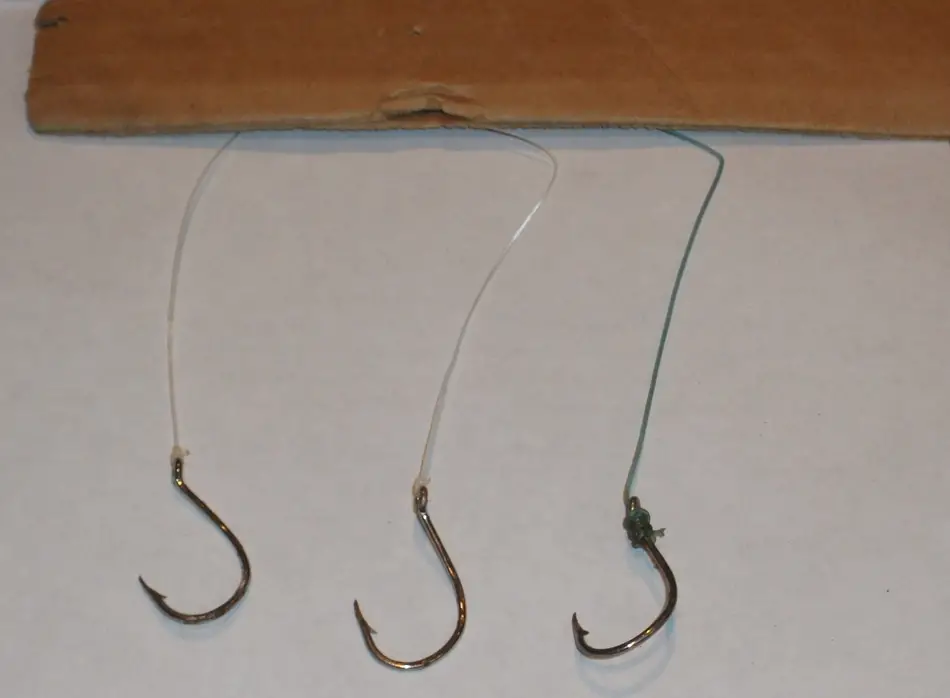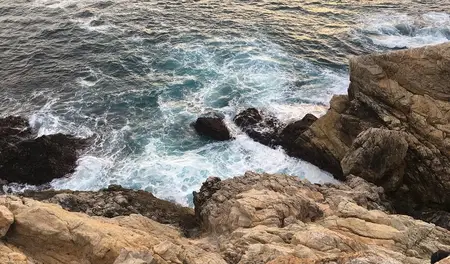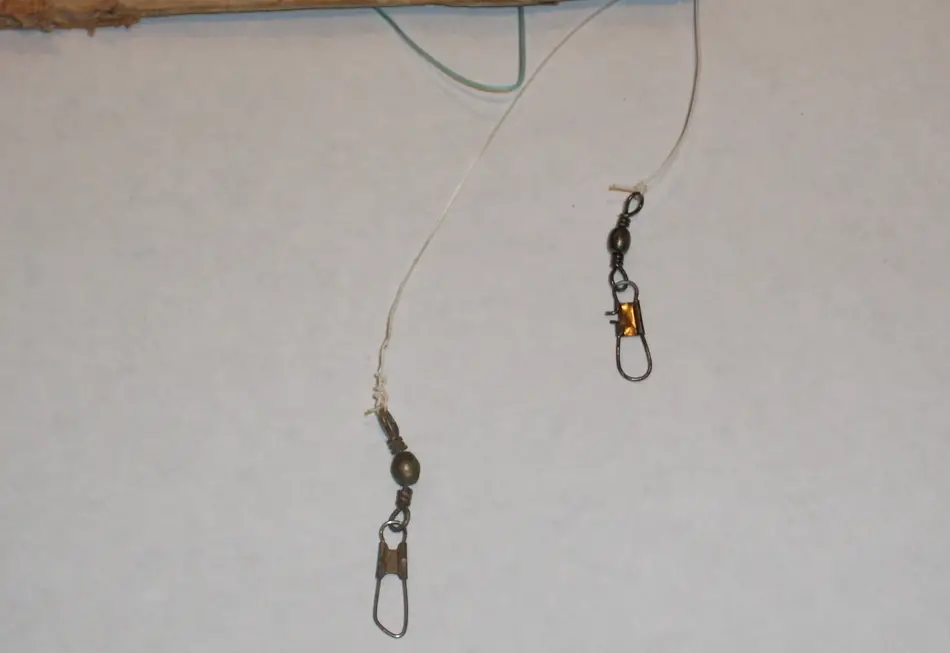You might have seen fishing leaders used by other anglers. Then thought to yourself … what is the point of tying on a shorter length of fishing line to the main fishing line? What is the difference between a fishing line and a leader? Would it just be simpler if you just attach the hook at the end of the main fishing line and call it day? The shorter answer is no. That is if you want a successful fishing trip.
So what is the purpose of a fishing leader? Fishing leaders have two main purposes:
- To provide your main fishing line with protection against damage and breaking.
- To have a better bait presentation.
Leaders are essential for a successful day of fishing and should be used 99% of the time.
Before I talk about making your own fishing leader line, first, you need to know what issues your leader line is going to solve for you.

What Problems Do Fishing Leader Lines Solve?
Leader lines are a great way to solve problems that anglers can face when fishing. Before you start building leader lines, you need to determine what problems you are going to face.

For example, when fishing for codfish, they tend to take cover at the bottom of the ocean in very rocky terrain. These rocks can be very sharp if the fishing line is rubbing against it, therefore, increasing your chances for the line to break. Codfish also have very sharp teeth that can chew through the fishing line.
Take the time to understand what possible conditions your line will be experiencing.
If you need help with trying to identify possible conditions that you need to think about, then don’t worry I got you covered.
Here are some things that I tend to come across most of the time.
1. Avoiding Line Breaks
It is easy to forget the abuse your line is taking underwater. Most people tend to underestimate the number of sharp objects underwater, such as rocks, barnacles, shells, reefs, etc.
Oh, did I forget to mention that some fish even have sharp teeth that can cut through your fishing line?
Selecting the proper fishing line will solve many of these issues. Typically fishing lines with a higher pound test will have larger diameters. This gives the line “more meat” that has to be cut through.
Monofilament fishing lines have great abrasion resistance. Abrasion resistance refers to the fishing line’s ability to withstand being rubbed against a rough surface.
2. Avoiding Snags
If you are fishing around rocky areas or where there are a lot of organic growth then you will be experiencing your fair share of snags.
Most snags occur because the hook catches a rock or organic growth and lack of experience by not jigging the rod hard enough.
There is not much you can do about the lack of experience other than keep on fishing. But there is something you can do about getting the hook out of the rocks and growth.
By making your leaders in such a way that gets your hook off the ground will greatly reduce the chances of getting snagged. A good example of a fishing leader configuration is called the drop shot.
See how the hook is higher up than the weight. This will keep the hook off the ground keeping it from getting snagged.
3. Reducing Line Visibility
Every fish will attack a bait differently. Some fish will attack anything that moves at full force. Some will investigate the bait before attacking it.
There are fish that will not go for the bait if they see the fishing line attached to the bait. Therefore, when you need the best bait presentation possible, then a leader made from Fluorocarbon fishing line will be your best bet.
Fluorocarbon fishing line allows light to easily pass through it while underwater. This makes the line practically invisible to fish.
For this reason, using fluorocarbon as your fishing leader line would be the best choice if you are worried about the bait presentation.
4. Avoiding Line Twist With Swivels
If you got a fish on the hook, the fish will be thrashing around creating line twist. In some cases, line twist can weaken your fishing line to the point where it can snap your line.
This can be solved by attaching your leader line to a swivel before tying it to your main fishing line. A swivel will allow your leader line to rotate freely without twisting your main fishing line.
How To Make A Fishing Leader Line
Making fishing leaders is pretty simple and does not require any fantasy equipment. All it will require is practice.
Here is what you will need to make a leader:
- Main Fishing Line
- Leader line
- Lure or Hook
- Swivel
- Fishing Weight or Sinker
- Pliers, Scissors, nail clippers, or Knife
Basic Type of Leaders
Most leaders are made from monofilament or fluorocarbon fishing lines. Each of these lines provides its own advantages and disadvantages.
Advantages:
- Fishing line is relatively cheap.
- Flexible which makes it easy to make the knots required.
- Able to stretch which will help absorb the impact of a fast-moving aggressive fish.
- Good abrasion resistance.
- Excellent knot strength.
Disadvantages:
- Deteriorates from exposure of ultraviolet (UV) light.
- Properties will change as it absorbs water.
- Able to stretch, making it hard to feel smaller bites.
- Lower density causes the line to float.
Advantages:
- High sensitivity to feel the smaller bites because of the little stretch in the line.
- Excellent abrasion resistance.
- Good knot strength.
- Low fishing line visibility.
- Does not absorb water.
- Does not deteriorate from ultraviolet (UV) light exposure.
Disadvantages:
- Fishing line is more expensive than monofilament.
- Denser than water which causes the line to sink.
Looking To Buy Some Fishing Leaders?
Check out these leader recommendations to learn more:
Best Monofilament Leaders
Best Fluorocarbon Leaders
Best Braided Leaders
Step 1: Determine The Leader Line Length
Determining the length of your leader is not an exact science. A lot of this is based on personal preferences and experiences.
Generally speaking, most leaders are about 24 to 30 inches in length. If I am using live bait, then you can go a bit longer, like 30 to 42 inches in length. The extra length will allow the live bait to swim around more.
Step 2: Tie Swivel to Leader Line

Swivels will allow your fishing leader line to freely rotate underwater with twisting your main fishing line.
Tie on a swivel to one end of your leader line using a surgeon loop.
You can use a swivel with a snap-on clip to easily remove and add weight to your rig setup.
Step 3: Tie Hook or Lure to Leader Line
There are various types of knots available to you when tying a hook. The snelling knot is an easy knot and provides strong knot strength.
Tie on a hook to the other end of the leader using the snelling knot.
Then you have just completed your first leader line. Keep practicing and you will eventually start pumping out leader lines like they are going out of fashion.
Do you need a leader for saltwater fishing?
Leader lines are needed for saltwater fishing. Saltwater fish are generally larger, stronger, and can have lots of teeth. If you don’t pick a leader line that can withstand the punishment that it will experience, then you will be losing a lot of fish.
Should I use mono or fluorocarbon leader?
Monofilament leaders should be used when you need a lighter line for more of a natural bait presentation and stretch to act as a shock absorber. Fluorocarbon leaders are heavier and stiffer which can give an unnatural bait presentation, but these lines are hard to see underwater which is great for bait presentation.
What is a leader in fishing?
A leader line is simply a segment of fishing line having the same or different strength or type of fishing line attached to a hook or lure on one end. The other end is attached to the main line. Leader lines are typically attached to the main line by a single know or swivel.
Can you use braided line as a leader?
Braided line can definitely be used as a leader line. Typically you want to use braided line as a leader when you are not concerned about abrasion or line visibility and using a slightly weaker braided line as a leader than your main line
Should my leader be lighter or heavier?
As a general rule of thumb, your leader line strength should be 5lb or the next common test above or below your mainline test. Typically a weaker leader line is used to protect your mainline in case you get snagged on something. Stronger leaders are typically used when line abrasion is a concern.
